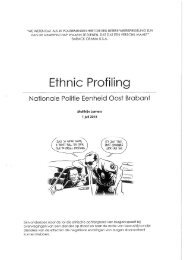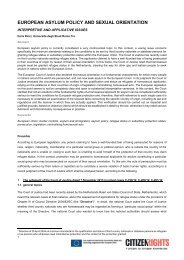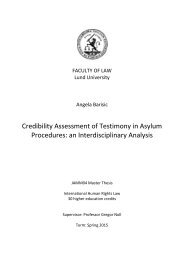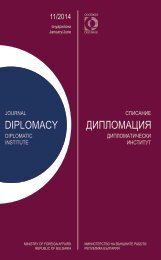AEMI
AEMI-2016-web
AEMI-2016-web
Create successful ePaper yourself
Turn your PDF publications into a flip-book with our unique Google optimized e-Paper software.
114 <strong>AEMI</strong> JOURNAL 2015<br />
factors that influenced European mobility,<br />
expansion and development from<br />
the late 1400s.<br />
The History of Ancient Trade<br />
Routes and European Development<br />
– a Brief Overview<br />
European economic and socio-cultural<br />
expansion gained a great deal of potency<br />
from the time when the Silk Road network<br />
of trade routes began to appear. 4<br />
Formally established during the Han<br />
Dynasty of China (206 BC – 220 AD),<br />
the ‘Silk Road’ linked the regions of<br />
the ancient world in commerce from as<br />
early as130 BC when the Han peoples<br />
of China officially opened trade with<br />
the west. 5 It extended 4,000 miles from<br />
Europe through Egypt, Somalia, the<br />
Arabian Peninsula, Iran, Afghanistan,<br />
Central Asia, Sri Lanka, Pakistan, India,<br />
Bangladesh, Burma, Java Indonesia,<br />
Philippines and Vietnam into China.<br />
This sophisticated system also sported<br />
entrepôt trading posts. 6<br />
From the 7th century BC to the 2nd<br />
century AD, the Greco-Roman world<br />
also traded along the ‘Incense route’ 7<br />
and the ‘Roman-India routes’. Aspects<br />
of these such as the Persian Royal Road<br />
were already in existence during the<br />
Achaemenid Empire thus as early as<br />
500-330 BC. 8 The Incense Route served<br />
as a channel for trading Arabian Frankincense<br />
and Myrrh; Indian spices, precious<br />
stones, pearls, ebony, silk and fine<br />
textiles, and from the Horn of African<br />
rare woods, feathers, animal skins and<br />
gold. Spices such as cinnamon, cassia,<br />
cardamom, ginger, and turmeric were<br />
known, and used for commerce in the<br />
Eastern World well into antiquity. These<br />
spices found their way into the Middle<br />
East before the beginning of the Common<br />
Era, 9 where the true sources of<br />
these spices were withheld by the traders,<br />
and associated with fantastic tales.<br />
Opium was also imported. The Egyptians<br />
had traded in the Red Sea, importing<br />
spices from the “Land of Punt” and<br />
from Arabia. Luxury goods traded along<br />
the Incense Route included Indian<br />
spices, ebony, silk and fine textiles. The<br />
spice trade was associated with overland<br />
routes early on but maritime routes<br />
proved to be the factor, which helped<br />
the trade grow. The Ptolemaic Dynasty<br />
developed trade with India using Red<br />
Sea ports. 10<br />
Silk Road merchants traded with Europe<br />
via the Byzantine Empire with the<br />
Italian city-states of Venice and Genoa<br />
acting as middlemen through Egypt,<br />
Somalia, the Arabian Peninsula, Iran,<br />
Afghanistan, Central Asia, Sri Lanka,<br />
Pakistan, India, Bangladesh, Burma,<br />
Java Indonesia, Philippines and Vietnam<br />
and China. 11 Trade on the Silk<br />
Road was a significant factor in the development<br />
of the civilizations of China,<br />
the Indian sub-continent, Persia, Europe<br />
and Arabia. It opened long-distance,<br />
political and economic interactions between<br />
these civilizations. Arab traders<br />
eventually took over conveying goods<br />
via the Levant and Venetian merchants<br />
to Egypt and Europe. Its main traders<br />
were the Chinese, Bactrians, Persians,<br />
Romans, Armenains, Indians and Sogdians.<br />
12<br />
Overland routes helped the spice<br />
trade initially, but maritime trade routes<br />
led to tremendous growth in commercial<br />
activities. In fact the Kingdom of<br />
Axum (CA 5th-century BC–AD 11th<br />
century) pioneered the Red Sea route









